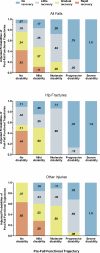The course of disability before and after a serious fall injury
- PMID: 23958741
- PMCID: PMC3812391
- DOI: 10.1001/jamainternmed.2013.9063
The course of disability before and after a serious fall injury
Abstract
Importance: Although a serious fall injury is often a devastating event, little is known about the course of disability (ie, functional trajectories) before a serious fall injury or the relationship between these trajectories and those that follow the fall.
Objectives: To identify distinct sets of functional trajectories in the year immediately before and after a serious fall injury, to evaluate the relationship between the prefall and postfall trajectories, and to determine whether these results differed based on the type of injury.
Design, setting, and participants: Prospective cohort study conducted in greater New Haven, Connecticut, from March 16, 1998, to June 30, 2012, in 754 community-living persons aged 70 years or older who were initially nondisabled in their basic activities of daily living. Of the 130 participants who subsequently sustained a serious fall injury, 62 had a hip fracture and 68 had another fall-related injury leading to hospitalization.
Main outcomes and measures: Functional trajectories, based on 13 basic, instrumental, and mobility activities assessed during monthly interviews, were identified in the year before and the year after the serious fall injury.
Results: Before the fall, 5 distinct trajectories were identified: no disability in 16 participants (12.3%), mild disability in 34 (26.2%), moderate disability in 34 (26.2%), progressive disability in 23 (17.7%), and severe disability in 23 (17.7%). After the fall, 4 distinct trajectories were identified: rapid recovery in 12 participants (9.2%), gradual recovery in 35 (26.9%), little recovery in 26 (20.0%), and no recovery in 57 (43.8%). For both hip fractures and other serious fall injuries, the probabilities of the postfall trajectories were greatly influenced by the prefall trajectories, such that rapid recovery was observed only among persons who had no disability or mild disability, and a substantive recovery, defined as rapid or gradual, was highly unlikely among those who had progressive or severe disability. The postfall trajectories were consistently worse for hip fractures than for the other serious injuries.
Conclusions and relevance: The functional trajectories before and after a serious fall injury are quite varied but highly interconnected, suggesting that the likelihood of recovery is greatly constrained by the prefall trajectory.
Figures


Comment in
-
Prognosis for recovery after injurious falls: clinical and policy implications of varying definitions of recovery.JAMA Intern Med. 2013 Oct 28;173(19):1786-7. doi: 10.1001/jamainternmed.2013.8252. JAMA Intern Med. 2013. PMID: 23959545 Free PMC article. No abstract available.
References
-
- Tinetti ME, Speechley M, Ginter SF. Risk factors for falls among elderly persons living in the community. N Engl J Med. 1988;319(26):1701–1707. - PubMed
-
- Nevitt MC, Cummings SR, Kidd S, Black D. Risk factors for recurrent nonsyncopal falls. A prospective study. JAMA. 1989;261(18):2663–2668. - PubMed
-
- Centers for Disease Control and Prevention (CDC) Self-reported falls and fall-related injuries among persons aged > or =65 years--United States, 2006. MMWR Morb Mortal Wkly Rep. 2008;57(9):225–229. - PubMed
-
- Tinetti ME, Doucette J, Claus E, Marottoli R. Risk factors for serious injury during falls by older persons in the community. J Am Geriatr Soc. 1995;43(11):1214–1221. - PubMed
-
- Nevitt MC, Cummings SR, Hudes ES. Risk factors for injurious falls: a prospective study. J Gerontol. 1991;46(5):M164–M170. - PubMed
Publication types
MeSH terms
Grants and funding
LinkOut - more resources
Full Text Sources
Other Literature Sources
Medical

